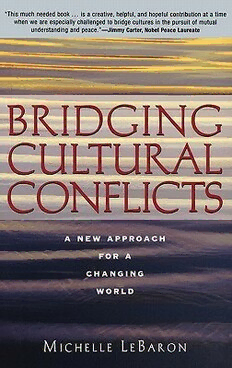
Bridging Cultural Conflicts: A New Approach for a Changing World PDF
Preview Bridging Cultural Conflicts: A New Approach for a Changing World
2 3 BRIDGING CULTURAL CONFLICTS 4 BRIDGING CULTURAL CONFLICTS A NEW APPROACH FOR A CHANGING WORLD Michelle LeBaron Foreword by Mohammed Abu-Nimer 5 6 CONTENTS List of Figures Foreword Mohammed Abu-Nimer Acknowledgments PART ONE Capacities for Engaging Cultural Conflict 1 Bridging Cultures: Uncovering Paths That Connect Us 2 Cultural Fluency in Conflict: An Overview 3 Cultural Fluency in Conflict: Currencies and Starting Points 4 Mindful Awareness as a Path to Cultural Fluency 5 Conflict Fluency 6 Engaging Difference PART TWO Practices for Engaging Cultural Conflict 7 Deepening the Colors: Personal Practices to Help Bridge Differences 8 Out of the Fire: Interpersonal Practices to Help Bridge Differences 9 On the Larger Stage: Intergroup Practices to Help Bridge Differences PART THREE Standing in Between: Third Parties and Cultural Conflict 10 Third-Party Roles in Cultural Conflict PART FOUR The Way Forward 11 Stepping into Shared Pictures Notes Resources 7 About the Author Index 8 LIST OF FIGURES Figure 4.1. Cultural and Personal Lenses Figure 5.1. Relationships: Smooth and Conflicted Figure 6.1. Dynamic Engagement and a Dialogic Spirit Figure 9.1. Snakes and Ladders Figure 10.1. Worldview, Cultural Identity, and Individual Habits of Attention To David and to all whose hearts belong to peace 9 FOREWORD Conflict emerges when people have difficulties dealing with differences-differences related to race, ethnicity, language, class, gender, age, religion, and more. These differences influence the lenses through which people view each other, often leading to mismatched perceptions and expectations, resulting in conflict. How can we constructively deal with these differences so that conflict contributes to positive political and social change? For twenty years I have worked with thousands of culturally diverse people to find ways to answer this question. Through this work I have come to see that cultural and power differences are central to the global and local conflicts we face. In Bridging Cultural Conflicts, Michelle LeBaron presents us with a timely guide for working with these complexities. This book is the first comprehensive road map connecting the fields of conflict resolution and intercultural communication. It shows readers how to actively handle cultural conflicts while also remaining authentic and true to their cultural identities. Michelle describes a set of new tools to address cultural conflict, including cultural fluency, conflict fluency, and mindful awareness. These tools are flexible resources for addressing the multifaceted interplay between culture and conflict at personal and political levels. Mindful awareness is fundamental, because conflict is never just "out there" but is always relational and social. We are well served by learning how our personal and collective cultural lenses shape what we see, how we relate to others, and what we perceive as our choices. There can be no intercultural conflict resolution if we do not move beyond our ethnocentric views and blind spots. Awareness of the multiple identities that each of us carries simultaneously (for example, one person may belong to many groups, including parents, soccer players, males, teachers, authors, Muslims, and so forth) is a basic tool for learning how to shift our perspectives and expand our behavioral choices. As we recognize our own and others' multifaceted identities, we are better able to see the "big pictures" of our conflicts and the contexts, both private and public, in which they take place. This awareness comes from being willing to see culture both within and among us and from developing cultural fluency. With her concept of cultural fluency, Michelle reminds us of our need for a language and an approach that can deepen our understanding of cultural dynamics. Cultural fluency goes hand in hand with conflict fluency, allowing us to explore and trace the contours of conflict and the differences it surfaces, rather than frantically seeking similarities and unity as so many approaches to intercultural relations suggest. The events of September 11, 2001, confronted us with the reality that it is essential to become aware of both our similarities and our differences, engaging in interfaith and intercultural dialogues to explore and understand our respective worldviews. Through dialogue we come to understand the nature and roles of culture in our changing worlds. Michelle uses the beautiful metaphor of an underground river to convey the influence of culture on our conflicts: "Cultures flow through our lives like underground rivers, powerfully nurturing, potently influencing, and sometimes dividing." This metaphor makes it clear that culture is an important influence, even when it seems, on the surface, that people are fighting over resources and culture has nothing to do with it. Everything around us is shaped and influenced by the underground, often unacknowledged, dynamics of culture. Because we do not see them, we often neglect the importance of cultural dynamics in our conflict resolution processes. Through careful examination of real-life examples, Michelle demonstrates the importance of cultural differences and then provides a clear conceptual framework for working through them. She writes in a voice that is accessible, drawing from the intercultural communication and conflict resolution fields. She distills research and experience, offering practices from the use of metaphors to adventure learning for addressing interpersonal and intergroup conflicts. Readers with or without academic training will find themselves acquiring creative tools for expanding their understanding of others as long as they are willing to try. The stories and examples used in this book are an enormous resource for learning, teaching, and training. 10
